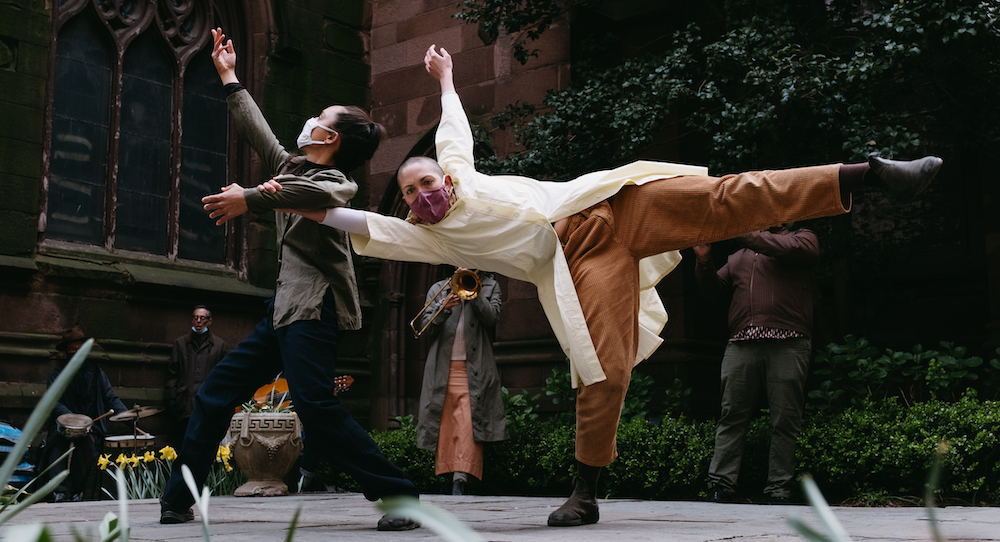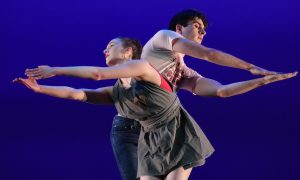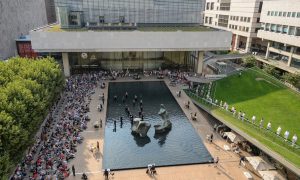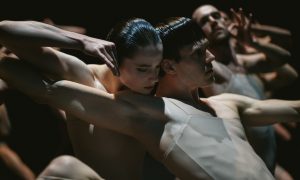Outside of the St. Ann and the Holy Trinity Church, Brooklyn, NY (also unlisted on YouTube).
Earth Day 2021 (March 22, 2021).
When we want to make positive change, where does that work start? Where can we find that sort of answer — does it come from inside or outside of ourselves? Do we sometimes forget about the centrality of our very body in making such change? Embodied Activism, created by Isabel Umali, Ashley Menestrina and Dustin Carlson, and presented on Earth Day 2021, brings questions like these to the forefront.
A layered, abstract and thought-provoking work, it urges us to tune into our own body in order to connect back to one another and the Earth — arguably, essential re-connections for surviving and thriving. Embodied Activism was curated and presented by KODA and hosted by St. Ann’s Church.
Umali, also a performer, leads the audience in humming together — humming being a communal sound that can potently connect us to one another and to our wider world. Fellow performers Menestrina and Yemen Brown stand behind her, present and prepared. “Wherever and whenever there is excess in our lives, it is a sign of deprivation,” Umali states — a poignant and memorable statement.
Umali asks audience members, “What does [that statement] make you want to do — fidget? Run? Hide?” This feels gently confrontative toward making people study themselves — a catalyst for meaningful change. It also engages the audience in a way that they’re involved rather than being passive observers, a postmodern innovation and interest. Lastly, those questions are squarely placed in the body and its actions — placing dance as the medium with which to investigate them.
Umali and Menestrina begin to dance, masked and wearing simple pedestrian dress with a flare of elegance. They give and take weight, dance in and out of each other’s kinespheres, move where they are and find new places in space. There’s a resonant moment where they clasp wrists and counterbalance each other’s weight. Meanwhile, brass and string instruments offer live accompaniment (from Carlson, Lathan Hardy, Satoshi Takeishi and Kalia Vandever). The three dancers move in and out of the harmony and melody lines, as if dancing with parts of the music itself.
Umali and Menestrina alternate lifting each other — speaking to mutual support. This idea intensifies as Menestrina turns slowly in space while fully supporting Umali’s weight. As Umali returns to the ground, she grabs on to Menestrina’s heels, and Menestrina steps while supporting Umali’s weight. In working toward a better world and simply living, sometimes we feel like we can’t go on — yet there are people there who can support us.
More broadly, the movement seems to be structured improvisation guided by thoughtful scripts. The dancers also seem to extensively know each other’s ways of moving and being in space; through that structured improvisation, they seem to be able to anticipate the choices of the other — pointing to the likely extensive hours that they’ve spent dancing together.
The tempo of the movement and music remains even and consistent, until Menestrina begins a solo with a quicker, jazzier beat, more articulation and accent in her joints emerging in the movement. The two other dancers are also dancing at other points in the space at this point, uniquely interacting with whatever they find in the space. Memorably, at this point Brown moves in a tree — caught in the point where the trunk branches off. The tree’s boughs move like fronds of a fern in the breeze.
In contrast, the two other dancers move right above the ground, sometimes rising higher but always maintaining deep connection with the surface below them. They fall, recover, and extend in a line through their whole body as cymbals clang — a striking moment of musicality and cohesiveness.
The musicians begin to follow the three dancers as they move throughout the space, dancing with the partner of their instrument in their own ways. Cabs drive by and a “CVS” sign is seen across the street, beyond viewers gathered around. This reminds me that 21st century life goes by even in a space of deep connection with one’s own body and soul, other artists similarly attuned, and the Earth itself — but that doesn’t mean that deep connection isn’t worth experiencing and working towards.
As the work progresses, different configurations of dancers move in and out of the central brick area, the area which we might call a stage space. Yet, essentially, the work remains a trio — or a septet, a group of seven, if one counts the musicians (which I would very much support doing). New melodies come in and quickly towards the latter part of the work, and the movement takes on a new speed and sense of groove; there’s quick footwork and a bounce through their upper bodies.
After another tempo shift, signaling a new section, two of the dancers find rocks and swing them side to side. Umali paces back and forth between them as if caught. Gradually, cautiously, she finds a rhythm with them — falling in line with their repeated side-to-side footwork. Finally, they find stillness and come closer together in space, beginning to find slow and gentle circling movements — another change in the speed and energy of their movement, this one drastic.
A gentle breeze blows on them, and windchimes are in the air. Closing their eyes, they seem to be feeling its softness on their skin. Taking on a bit more movement, they shift and circle like light wind on fallen leaves or plants in a cluster. The score has a feel of moving like wind as well, going high and low in free movement, exploring all terrains.
Ultimately, they slowly fall into a three-person pile, sweat demonstrating their immense physical work and dedication to the performance. The audience claps and shouts congratulations and appreciation. Also appreciating abstraction and the beauty of what these artists just offered for what it is, my mind also ponders potential meaning.
Recognizing a theme of air and wind in the closing section, I wonder if the other four elements were represented — the more fluid sections in the beginning illustrating space and or water, the section with the rock portraying earth, and the groovy, high-energy section representing fire? It’s an enjoyable thought exercise to ponder such meanings, with the space for other meanings being just as valid.
The beauty and intriguing abstraction notwithstanding, I could understand some viewers having trouble staying with the performance — particularly children and those without much prior exposure to post-modern dance. The audience engagement at the beginning of the program was beautifully done, and perhaps that included at a point or points in the middle of the program could have broken up the continuous trio structure.
Yet perhaps the call for patience and staying attuned was part of the point; staying awake to the needs of our bodies, our communities, and the wider Earth is continuous work calling for significant perseverance (when called to it, one is never “done”) — work that is not always so clear. I think also on the stamina, perseverance, and whole-hearted commitment of these artists, performing with their whole selves for forty-plus minutes straight.
Overall, Embodied Activism calls us to stay with and appreciate the beauty within the never-ending work and the long journey of spurring positive change — indeed, the work held both beautiful individual moments as well as beauty as a cohesive whole. With eyes and hearts opened, such beauty is there for the experiencing.
By Kathryn Boland of Dance Informa.















